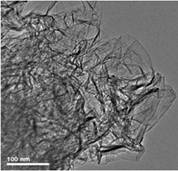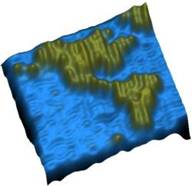Productive Nanosystems as a Milestone Toward Geoethical Nanotechnology
James B. Lewis, Ph.D.
Page 3 of 7
Further development along the first path would lead to more advanced tip-arrays that could fabricate various three-dimensional materials. Further development along the second path would lead to APPNs capable of guiding the assembly of a diverse selection of monomer building  blocks to make robust composite nanosystems based upon polymers. A decade or more down the line, the two paths could converge to produce APPNs capable of building solids of complex structures and diverse materials.
blocks to make robust composite nanosystems based upon polymers. A decade or more down the line, the two paths could converge to produce APPNs capable of building solids of complex structures and diverse materials.
The tip-based approach has succeeded in placing many types of atoms and molecules on surfaces, but has mostly involved lateral displacements of weakly bound species. Covalently bonding species to build three-dimensional structures remains a major challenge. One approach under development is patterned atomic layer epitaxy, or ALE, in which the atomically precise removal of atoms or molecules from a surface creates reactive sites for atomically precise crystal growth. Challenges include the identification of appropriate combinations of surfaces and building blocks, the development of more reproducible structures for probe tips, the development of tips that can capture species in precise configurations and deposit them precisely for mechanosynthesis, the simultaneous use of arrays of many tips, and improvements in tip positioning mechanisms. One promising path to meeting the latter two challenges is the development of MEMS-based closed-loop nanopositioning systems that could operate at high frequencies.
The bio-based approach has succeeded in constructing large, complex objects from DNA, including structures of many shapes, devices capable of mechanical motion, and atomically precise frameworks that can position other nanostructures to atomic precision. Protein molecules can be designed to bind to specific sites on DNA and to a wide range of atomically precise functional elements. These specialized functional structures include organic molecules and organometallic complexes, clusters and quantum dots, nanotubes, and biological molecular motors and other biomolecular devices. They have a variety of catalytic, electronic, optical, and mechanical properties. Challenges for the bio-based approach include the restricted range of properties and stability of biopolymers, and the fact that bulk DNA production costs are in the dollar per milligram range. Also, the design of complementary interfaces for the atomically precise self-assembly of molecular building blocks is simple for DNA, but still difficult for proteins.
The tip-based and bio-based approaches to APM are complementary. For example, tip-based APM may lead toward manufacturing molecular building blocks for MMCNs from materials like ceramics, which are higher performance than are biopolymers.
The roadmap identifies one possibility for an early generation APPN that could be used to develop more capable APPNs. Systems analogous to ribosomes could link together different types of monomers to make atomically precise polymers that are more stable, predictable, and rigid than are biopolymers, and have specialized functional structures that are not found in biopolymers.
Components, devices, frameworks, starting points
The roadmap provides an overview of components and devices, systems and frameworks, and fabrication, design, and characterization methods that are currently available to use to develop APPNs.
Very briefly, components include modules that can be assembled from monomers like DNA nucleotides and protein amino acids, stiff atomically flat crystal surfaces like silicon, sheets like graphene and molybdenum disufide, polymers like DNA and proteins that can be folded to place functional groups in predictable 3D locations, strong polymers like carbon nanotubes that are at least locally atomically precise, and nanotubes of DNA or peptides formed by self-assembly guided by weak non-covalent bonds. Other components include polymers called dendrimers that are assembled by a branching growth process, viral capsids, and other large, biological nanoparticles that could serve as atomically precise frameworks to which other atomically precise components could be attached.
Ceramic nanocrystals of metal oxides and II-VI semiconductors have a number of useful properties. Although they are not usually atomically precise, some types are and more types may become amenable to atomically precise preparation as methods improve. Some smaller metallic nanocrystals are available as atomically precise clusters. Likewise, there is a vast menagerie of graphene nanostructures, ranging from atomically precise fullerenes and small planar, atomically precise graphene sheets, to structures in which only some aspects are atomically precise, such as larger flakes, single-walled and multi-walled carbon nanotubes, nested fullerenes, and nanohorns. There are also many types of inorganic nanotubes with interesting and unique properties, although much work needs to be done to approach atomic precision in structure. Semiconductor and metallic nanowires also have useful properties, but will probably not be available as atomically precise structures until some progress in APM has occurred.

Graphene Sheet
Credit: Rod Ruoff, University of Texas at Austin
www.cosmosmagazine.com/node/2220/full
April 6, 2009 10:56AM EST
A number of atomically precise motors and actuators are available. Biology provides a number of both linear and rotary molecular motors powered by either ATP (the universal energy currency of life) or the flow of protons across a membrane. Various examples pack DNA into viral capsids, power flagella so different types of cells can swim, move fibers so muscles can contract, transport cargo along the cellular skeletal network, use mechanical energy for chemical synthesis, and reel in DNA like fishing rod line. A synthetic rotary motor uses light energy to interconvert two geometries around a double bond joining two carbon atoms in a way that is both unidirectional and stoppable. A number of different motors and actuators built from DNA nanostructures are powered by the addition of short strands of DNA from the surrounding solution. Different DNA sequences can be used so that multiple motors and actuators in an array could be independently controlled.
Of particular importance to the development of APPNs are atomically precise frameworks that can be used to organize components for APM and to interface with structures that are not atomically precise, such as nanolithographically patterned surfaces and circuits.
One type of framework would be atomically precise patterns created on crystal surfaces using computer controlled positioning systems—for example, patterned atomic-layer epitaxy on silicon wafers. The atomically precise structures that could be made with such scanning probe fabrication methods would be very small, even if MEMS-based nanopositioning systems were used to provide parallel fabrication capabilities. The roadmap suggests that a number of small atomically precise structures, each made of a different material and characterized by a different lattice constant, could be designed so that they could be linked together to form more complex modular structures.

The nanoscale map sketches the Americas at one 200-trillionth of their actual size (Image: Paul Rothemund of Caltech)
www.newscientist.com/article/dn8853-dna-origa... April 6, 2009 11:15AM EST
Other frameworks could be produced by atomically precise self-assembly of biomolecular components. A principal example is the scaffolded DNA origami technique, which has been used to fabricate many different 100-nm scale atomically precise two-dimensional structures. Because DNA is built from only four monomers (called nucleotides) that interact in a limited number of structural motifs (most usefully, the familiar DNA double helix), structural DNA nanotechnology makes possible the design and fabrication of relatively large, complex, intricate structures, but the DNA double helix is also relatively bulky (2-nm diameter) so that the control of molecular shape and surface properties is also relatively coarse-grained (3.5 by 6 nm for DNA origami).
This limitation can be addressed through the use of a modular molecular composite nanosystems (MMCNs) approach, in which DNA is used to build a framework for the arrangement in space of other molecular modules that offer finer-grained structures and functionality. Potentially, DNA engineering could lead to 3D frameworks that provide hundreds to thousands of uniquely addressable locations.